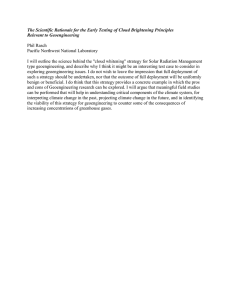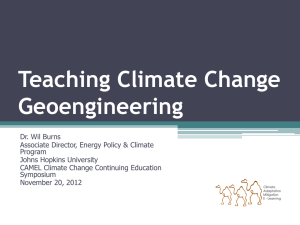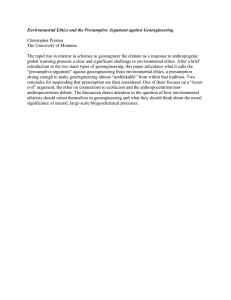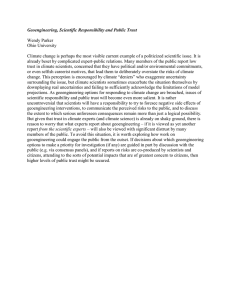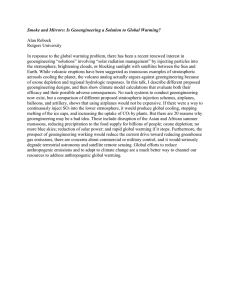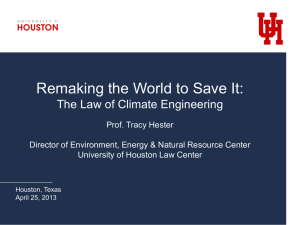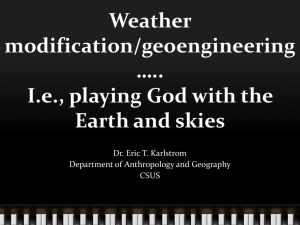AMS Policy Statement on Geoengineering the Climate System
advertisement
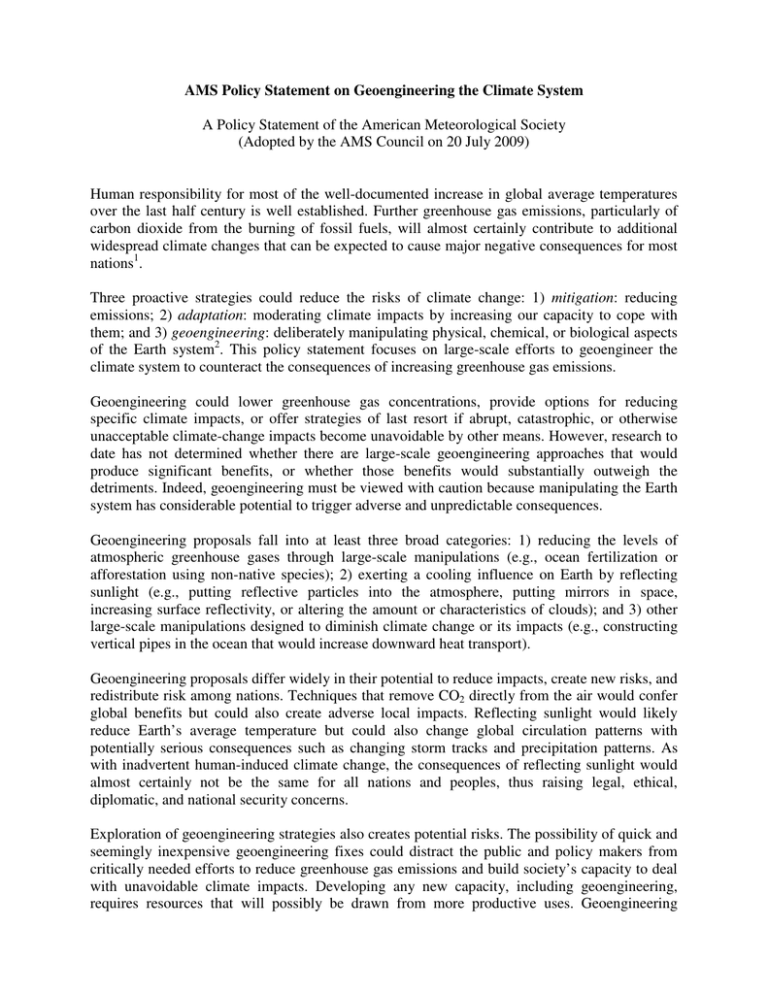
AMS Policy Statement on Geoengineering the Climate System A Policy Statement of the American Meteorological Society (Adopted by the AMS Council on 20 July 2009) Human responsibility for most of the well-documented increase in global average temperatures over the last half century is well established. Further greenhouse gas emissions, particularly of carbon dioxide from the burning of fossil fuels, will almost certainly contribute to additional widespread climate changes that can be expected to cause major negative consequences for most nations1. Three proactive strategies could reduce the risks of climate change: 1) mitigation: reducing emissions; 2) adaptation: moderating climate impacts by increasing our capacity to cope with them; and 3) geoengineering: deliberately manipulating physical, chemical, or biological aspects of the Earth system2. This policy statement focuses on large-scale efforts to geoengineer the climate system to counteract the consequences of increasing greenhouse gas emissions. Geoengineering could lower greenhouse gas concentrations, provide options for reducing specific climate impacts, or offer strategies of last resort if abrupt, catastrophic, or otherwise unacceptable climate-change impacts become unavoidable by other means. However, research to date has not determined whether there are large-scale geoengineering approaches that would produce significant benefits, or whether those benefits would substantially outweigh the detriments. Indeed, geoengineering must be viewed with caution because manipulating the Earth system has considerable potential to trigger adverse and unpredictable consequences. Geoengineering proposals fall into at least three broad categories: 1) reducing the levels of atmospheric greenhouse gases through large-scale manipulations (e.g., ocean fertilization or afforestation using non-native species); 2) exerting a cooling influence on Earth by reflecting sunlight (e.g., putting reflective particles into the atmosphere, putting mirrors in space, increasing surface reflectivity, or altering the amount or characteristics of clouds); and 3) other large-scale manipulations designed to diminish climate change or its impacts (e.g., constructing vertical pipes in the ocean that would increase downward heat transport). Geoengineering proposals differ widely in their potential to reduce impacts, create new risks, and redistribute risk among nations. Techniques that remove CO2 directly from the air would confer global benefits but could also create adverse local impacts. Reflecting sunlight would likely reduce Earth’s average temperature but could also change global circulation patterns with potentially serious consequences such as changing storm tracks and precipitation patterns. As with inadvertent human-induced climate change, the consequences of reflecting sunlight would almost certainly not be the same for all nations and peoples, thus raising legal, ethical, diplomatic, and national security concerns. Exploration of geoengineering strategies also creates potential risks. The possibility of quick and seemingly inexpensive geoengineering fixes could distract the public and policy makers from critically needed efforts to reduce greenhouse gas emissions and build society’s capacity to deal with unavoidable climate impacts. Developing any new capacity, including geoengineering, requires resources that will possibly be drawn from more productive uses. Geoengineering technologies, once developed, may enable short-sighted and unwise deployment decisions, with potentially serious unforeseen consequences. Even if reasonably effective and beneficial overall, geoengineering is unlikely to alleviate all of the serious impacts from increasing greenhouse gas emissions. For example, enhancing solar reflection would not diminish the direct effects of elevated CO2 concentrations such as ocean acidification or changes to the structure and function of biological systems. Still, the threat of climate change is serious. Mitigation efforts so far have been limited in magnitude, tentative in implementation, and insufficient for slowing climate change enough to avoid potentially serious impacts. Even aggressive mitigation of future emissions cannot avoid dangerous climate changes resulting from past emissions, because elevated atmospheric CO2 concentrations persist in the atmosphere for a long time. Furthermore, it is unlikely that all of the expected climate-change impacts can be managed through adaptation. Thus, it is prudent to consider geoengineering’s potential benefits, to understand its limitations, and to avoid illconsidered deployment. Therefore, the American Meteorological Society recommends: 1) Enhanced research on the scientific and technological potential for geoengineering the climate system, including research on intended and unintended environmental responses. 2) Coordinated study of historical, ethical, legal, and social implications of geoengineering that integrates international, interdisciplinary, and intergenerational issues and perspectives and includes lessons from past efforts to modify weather and climate. 3) Development and analysis of policy options to promote transparency and international cooperation in exploring geoengineering options along with restrictions on reckless efforts to manipulate the climate system. Geoengineering will not substitute for either aggressive mitigation or proactive adaptation, but it could contribute to a comprehensive risk management strategy to slow climate change and alleviate some of its negative impacts. The potential to help society cope with climate change and the risks of adverse consequences imply a need for adequate research, appropriate regulation, and transparent deliberation. [This statement is considered in force until July 2012 unless superseded by a new statement issued by the AMS Council before this date] © American Meteorological Society, 45 Beacon Street, Boston, MA 02108-3693 1 For example, impacts are expected to include further global warming, continued sea level rise, greater rainfall intensity, more serious and pervasive droughts, enhanced heat stress episodes, ocean acidification, and the disruption of many biological systems. These impacts will likely lead to the inundation of coastal areas, severe weather, and the loss of ecosystem services, among other major negative consequences. 2 These risk management strategies sometimes overlap and some specific actions are difficult to classify uniquely. To the extent that a geoengineering approach improves society’s capacity to cope with changes in the climate system, it could reasonably be considered adaptation. Similarly, geological carbon sequestration is considered by many to be mitigation even though it requires manipulation of the Earth system.
